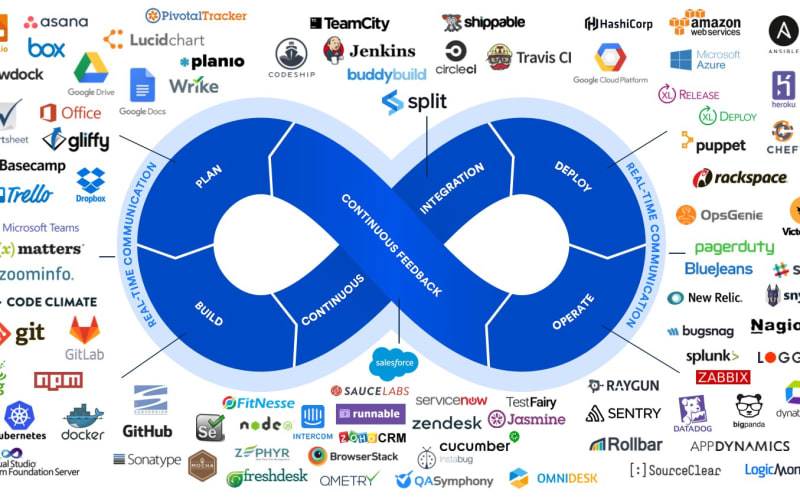A DevOps toolchain is a set of digital tools used to perform complex software delivery tasks. The tools in the toolchain are usually executed one after the other, with one tool’s output being the input for the next tool.
This is why the standardization of these tools is really important. Above all, DevOps toolchains should improve collaboration between developers, automate any necessary tasks, and enable more quality software. At the same time provide observability over the infrastructure and applications.
Seamless integration between tools can be really hard to accomplish. Especially if you don’t have years of experience in the DevOps field. For instance, each tool has its own specific capabilities and syntax. Resolving gaps, overlaps, and dependencies between tools is a cumbersome task. This is also known as tool sprawl. Using a lot of tools can be heavy on your cost management. It can dry up the budget that you can use to address innovation opportunities for your business.
The DevOps lifecycle
A DevOps toolchain should cover all phases of the DevOps process, which are:
Planning and collaboration
Communication and collaboration between the development, testing, and product teams are essential for faster and quality software releases. Planning provides transparency in the company. It makes sure everyone is on the same page.
Build
The part of creating the application starts once the planning is done. This includes designing the solution, developing the code, and verifying the developed code. The solution needs to pass acceptance and integration tests.
CI/CD
A CI/CD pipeline includes infrastructure provisioning and automation, configuration management, and orchestration. Automating continuous integration and delivery enables teams to get features out more frequently. With that, they get feedback faster to be able to improve the product.
Operations and monitoring
Good monitoring and operations lead to better incident responses. In addition, it helps with the analysis and identification of error root causes in the system. With that, it makes it more resilient.
Continuous feedback
Listening to your customers can help drive improvement and innovation in the business. Similarly, analyzing and incorporating feedback helps in being more efficient in releasing features that customers actually want and need.
Image source: https://dzone.com/articles/the-devops-toolchain
Built-in DevOps toolchain
There are two possible ways to create a DevOps toolchain: the built-in or a custom one. With the build-in approach, you can use a tool already developed by someone and tailor it to your specific needs. Using a ready-to-go tool allows better standardization and fewer integrations along the way.
This year’s State of DevOps Report has shown there is a great advancement in the platform approach to software delivery. Companies are finding it a necessity. Mainly when there are several different teams that need to accomplish the same goal – get products delivered to the market.
Imagine 10 teams, each with its own technology stack, toolchain, and processes. You’re going to have all these teams trying to solve similar problems, spending way too much time on evaluating technologies, integrating them, maintaining the infrastructure, and more. That’s time that could be better spent building and improving the actual products your teams are responsible for.
The platform should provide the infrastructure, environments, deployment pipelines, and services to the application teams. After that, teams use the platform to build, deploy, and run applications.
The main reason why the built-in DevOps toolchain works is that it lifts a weight off developers. The constant context-switching between application development and infrastructure operations reduces productivity. Therefore, having clear contexts between the platform and the application enables more quality software.
Custom DevOps toolchain
The custom toolset means that you need to select the tools you need for your toolchain. However, here you’ll need to orchestrate all the different tools to work together.
This approach is good since it enables you to use the best of breed tools. It’s also pretty hard to get vendor-locked in with this approach. But standardization is not really much of a given feature.
To create a custom toolchain you’ll need to dedicate team members to tools investigation. compatibility, and dependency matching between tools. If the tools don’t integrate well with each other, it can be challenging to share information between them. In other words, team members should understand infrastructure operations and the tools they need to manage. Moreover, the custom approach can also be more costly than the built-in approach.
Conclusion
In conclusion, selecting tools for your DevOps toolchain is a delicate and timely process. It requires a lot of research, testing, and proof of concept. Development and delivery tools tend to stick longer into an organization, unlike any other type of tool. As a result, they need careful consideration to fit the entire team.








Top comments (0)